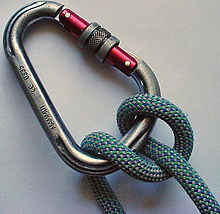Munter hitch
| Munter hitch | |
|---|---|
 |
|
| Names | Munter hitch, HMS, Italian hitch, Crossing hitch (ABoK #1818) |
| Category | Hitch |
| Related | Half hitch, Zigzag Knot (ABoK #1195), Monster Munter |
| Releasing | Non-jamming |
| Typical use | Belaying |
| Caveat | Wears out the rope when used for descending |
The Munter hitch, also known as the Italian hitch or the Crossing Hitch, is a simple knot, commonly used by climbers, cavers, and rescuers as part of a life-lining or belay system. To climbers, this knot is also known as HMS, the abbreviation for the German term Halbmastwurfsicherung, meaning half clove hitch belay. This technique can be used with a special "pear-shaped" HMS locking carabiner, or any locking carabiner wide enough to take two turns of the rope. The Munter hitch is named after a Swiss mountain guide, Werner Munter, who popularised its use in mountaineering around 1970.
The hitch is simply a set of wraps using a rope or cord around an object, generally a round object like a pipe, pole or more commonly, a carabiner. Its main use is as a friction device for controlling the rate of descent in belay systems.
The Munter hitch creates friction by having the rope rub on itself and on the object it has been wrapped around. There is no static friction (localised abrasion) on any part of the rope as it is a continuously moving knot. One very useful aspect of the Munter is its reversibility; it can be pulled from either side of the rope and it still works just as effectively.
As with most belay devices and some hitches the Munter can be tied off (dogged/dogged off) to maintain tension in a manner which is easily released under tension, this is often referred to as a Munter-Mule or MMO (Munter Mule Overhand)
The control rope (the rope not going to the load) is tied to the load rope with a Mule Knot (aka Halter hitch) - not a slipped overhand! - and the bight (loop) that sticks out is tied in an overhand around the load rope. A carabiner is then sometimes clipped through the end of the bight and around the load rope.
Examples of when a tie off would be employed include:
When a belayer needs to transfer the load from his harness to the anchor to escape the system: a rope grab (mechanical or friction knot/Prusik) is placed on the load line towards the load, rope is terminated on the rope grab (or the tails of accessory cord are used when using a cordelette with a Prusik as a rope grab) and runs back to the anchor where a Munter mule is tied under tension. The load can then be lowered (transferred) from the original belay onto the Munter Mule via the rope grab. The new line is often consider independent of the safety system so the original belay needs to be maintained throughout the process and secured back to the anchor before the system can be left unattended.
...
Wikipedia
